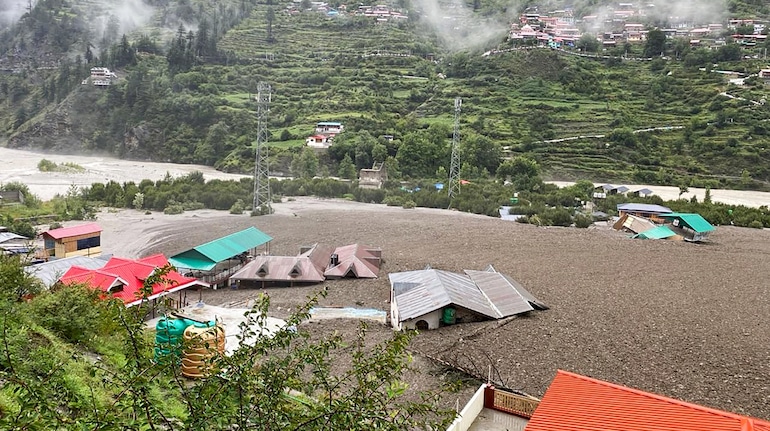
There was no single villain — only many small betrayals. We carved hotels into the river’s margin, stripped the slopes of their roots, and then acted surprised when the mountain answered back.
The August 6 2025 Uttarkashi disaster wasn’t just a “cloudburst.” Satellite and expert analyses indicate that a glacial lake outburst or glacier collapse likely triggered the flood. The wreckage, however, became a human-made disaster. Riverbed encroachment and unplanned tourism growth contributed to the disaster. Massive deforestation also played a part. Weak regulation turned a sudden natural pulse into a rolling wall of mud, debris, and loss.
Why human actions mattered?
- Riverbed encroachment. Buildings, hotels and temporary constructions were placed inside or directly adjacent to natural floodplains. Narrowed channels concentrated flood energy into towns and tourist hubs.
- Unplanned tourism expansion. The tourism boom demanded roads, hotels, water and waste systems — often built quickly and without ecological assessments. Trails, informal campsites and parking scars stripped vegetation and redirected runoff.
- Deforestation and slope destabilization. Tree roots anchor soil. Cutting slopes to make room for development or roads removed that anchor. Once loose, moraines and unstable soils turn into high-speed slurry during sudden floods.
- Weak governance and corruption. Where approvals are opaque and enforcement weak, construction flouts rules. Illegal or improperly sanctioned projects put people in harm’s path.
Why the mud slurry was worse than the water alone
Water carved a path; soil and rocks destroyed everything in it. Deforested slopes make landslides more likely and more massive. Tourism infrastructure multiplies points of failure: sewage, roads, cut slopes and hotels all add to the rubble that floods carry. The difference between a difficult flood and a catastrophic one was human: the loss of the mountain’s buffer.
A chain that led to collapse
- Glacial lake or glacier failure releases a sudden surge.
- Steep, narrow valleys accelerate flow to terrifying speeds.
- Deforested, destabilized slopes supply enormous amounts of soil and debris.
- Encroached riverbeds and settlements leave no place for the flood to disperse.
- Result: catastrophic mudflow, infrastructure collapse, and loss of life.
All of these turned one extreme event into a wholesale collapse of landscape and livelihoods.
Tourism: the slow pressure that makes a single event catastrophic
Tourism can be regenerative — but only when planned with limits and respect. In Uttarkashi, the boom meant:
- More construction on unstable slopes and near riverbanks (short-term gain, long-term risk).
- Greater waste, water extraction, and local contamination that weaken soil and increase erosion.
- Informal trails and campsite areas that strip vegetation and concentrate runoff.
- Economic pressure to continue building instead of enforcing moratoria or safe setbacks.
Think of tourism here as adding gasoline to a landscape already warming and unraveling from climate-driven glacial melt.
The chain reaction (simple): Glacier → Water → Deforested Slope → Mud Slurry → Town
- Glacial event (GLOF/glacier collapse) releases a huge pulse of water and ice.
- Steep downvalleys and loose moraines accelerate debris.
- Deforested slopes and built riverbeds offer no resistance.
- Mud, rocks and water barrel into settlements and infrastructure.
- Human loss and ecological damage compound future vulnerability.
What we must do practical, urgent, and do-able
This is not a “blame only” list — it’s an action blueprint. If you care, do one thing from each tier.
Policy & governance
- Immediate halt on new building projects in designated flood zones and areas with unstable slopes.
- Enforce—don’t just legislate—land-use rules. Publish violations, owners and approvals. Transparency kills corruption.
- Mandate river-setback widths and prohibit permanent structures on the natural floodplain.
- Resettle highest-risk settlements with fair compensation and community-led planning.
Land & nature fixes (restoration that actually reduces future risk)
- Large-scale reforestation with native species to stabilize slopes and rebuild root networks.
- River restoration to re-open natural flood channels and reconnect floodplains where possible.
- Slope engineering using nature-based solutions (bioengineering, terraces, check dams) rather than concrete only.
Tourism & business (operators & travelers)
- Cap visitor numbers seasonally, enforce permits and eco-standards.
- Eco-certify hotels and guides; tie licenses to compliance with waste, sewage and construction standards.
- Educate tourists: low-impact travel, pack-out waste, use certified operators only.
Community & resilience (what local people and supporters can do)
- Community early-warning systems tied to glacial monitoring and downstream sensors.
- Local disaster training and evacuation routes mapped and practiced.
- Support local livelihoods that don’t depend on risky construction — eco-guiding, agroforestry, crafts.
Civil pressure (what you can do right now)
- Demand transparency: ask local authorities for land-use maps, approved construction lists, and environmental clearances.
- Back local NGOs doing reforestation and rescue-preparedness.
- Share responsible travel advice — don’t promote resorts in fragile zones.
- Use your vote and voice to hold development-friendly politicians accountable.
A simple, powerful truth
We can’t stop glaciers from melting, but we can stop turning every natural shock into a catastrophe.
The mountain didn’t fail us alone we were already failing it.

No responses yet